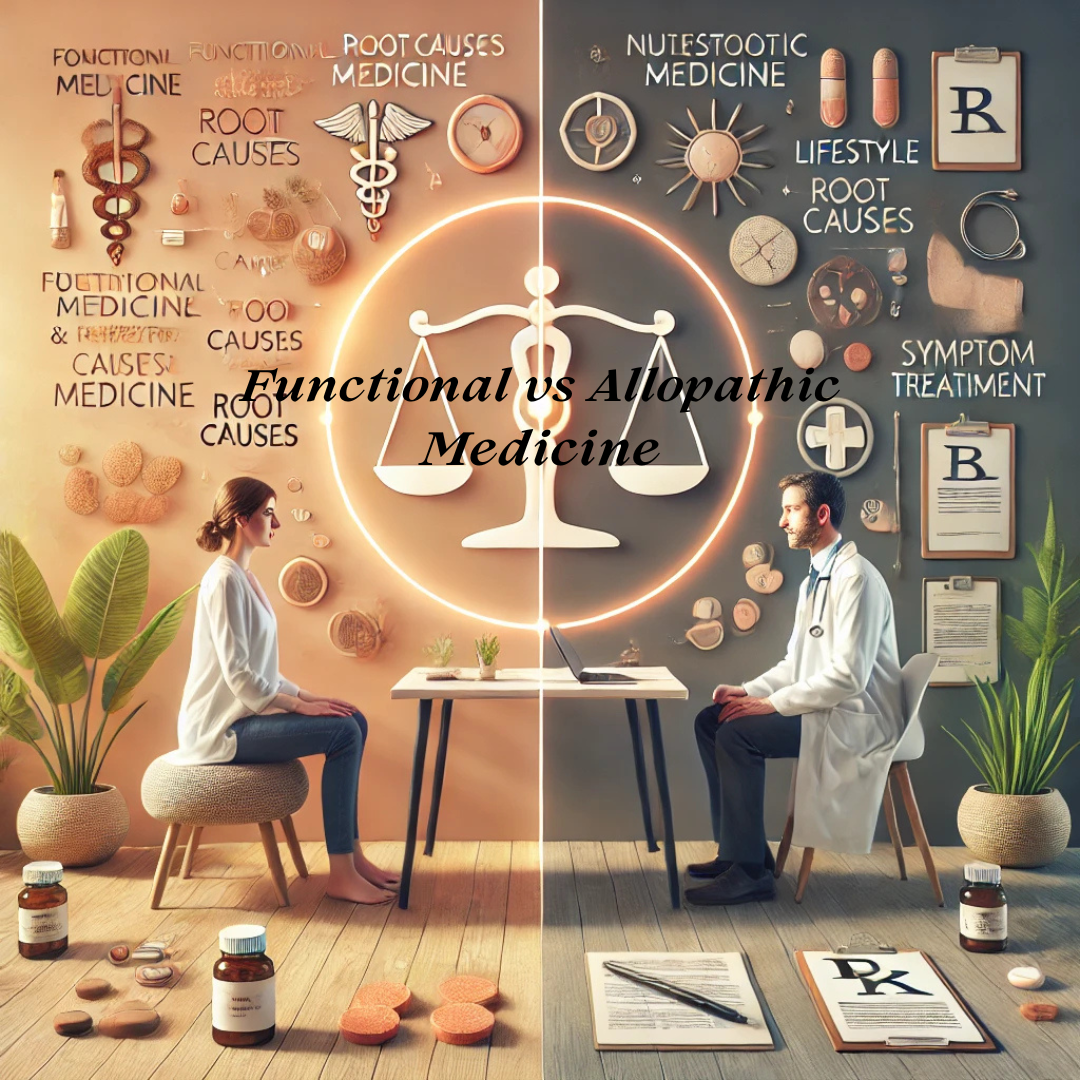Functional Medicine vs. Allopathic Medicine: Understanding the Key Differences

Introduction: Two Models, One Goal—Your Health
When you visit a doctor for chronic fatigue, joint pain, or digestive issues, you’re often given a diagnosis—and a prescription. That’s the allopathic model, also known as conventional or Western medicine.
But what if the diagnosis doesn’t explain why you’re sick? What if there’s a deeper cause behind your symptoms?
This is where functional medicine comes in.
While both allopathic and functional medicine aim to improve health, their approach, philosophy, and tools differ significantly. In this blog, we’ll break down these two medical models, explain their strengths, and help you understand which may be right for your long-term wellness goals.
What Is Allopathic Medicine?
Allopathic medicine refers to the conventional Western medical model practiced in hospitals, urgent care centers, and most primary care offices.
It’s built on:
- Diagnosing disease through lab tests and imaging
- Treating symptoms with medications, surgeries, or procedures
- Evidence-based protocols developed from large-scale clinical trials
Allopathic medicine is invaluable for:
- Emergencies and trauma
- Acute infections
- Life-saving surgeries
- Diagnosing advanced pathology (e.g., cancer, stroke)
Example:
A patient with high blood pressure is prescribed a beta-blocker. It lowers the number, but may not address poor diet, stress, or inflammation causing the problem.
What Is Functional Medicine?
Functional medicine is a systems-based, patient-centered approach that aims to identify and address the root cause of illness—not just the symptoms.
It integrates:
- Personalized lab testing
- Lifestyle medicine (nutrition, sleep, movement)
- Gut health and microbiome science
- Hormone, immune, and detox balance
- Environmental toxin evaluation
- Natural and pharmaceutical therapies
Example:
That same patient with high blood pressure might undergo advanced testing to assess insulin resistance, adrenal stress, nutrient deficiencies, and inflammation—all of which may be corrected to reverse the need for medication long term
Core Philosophical Differences
Aspect Allopathic Medicine Functional Medicine
Goal Manage disease and reduce symptoms
Identify and correct root cause Approach Disease-centered Patient-centered
Diagnostics Standard labs and imaging Advanced testing (gut, hormones, micronutrients, genetics)
Treatment Medications, surgery, procedures Nutrition, lifestyle, supplements, root-cause correction
Time with patient 7-15 minutes 45-90 minutes
Chronic care model Symptom suppression Reversal and restoration
Strengths of Allopathic Medicine
Allopathic medicine shines in:
- Acute care: Heart attacks, infections, strokes, and trauma
- Specialization: Cardiologists, endocrinologists, neurologists, etc.
- Technology: Imaging, surgical precision, emergency response
- Evidence base: Large trials supporting specific interventions
But it often falls short in chronic disease, where multiple body systems are involved and the focus remains on suppressing symptoms instead of exploring why the body is malfunctioning.
Strengths of Functional Medicine
Functional medicine excels in:
- Chronic illness: Fatigue, IBS, autoimmune disease, fibromyalgia, depression
- Prevention and optimization: Biohacking, longevity, hormone balance
- Root-cause focus: Gut health, toxin load, inflammation, nutrient status
- Whole-body integration: Mind, body, lifestyle, genetics
- Empowering the patient: Personalized plans and education
By viewing the body as an interconnected system, functional medicine treats the person, not just the diagnosis.
Diagnostic Testing: Depth Over Breadth
Allopathic labs often tell you if you’re “in range,” but normal isn’t always optimal.
Functional medicine expands testing to include:
- Comprehensive hormone panels
- Adrenal function and cortisol rhythm (DUTCH test)
- Micronutrient levels (zinc, B12, magnesium, etc.)
- Food sensitivity and gut permeability (leaky gut)
- Stool microbiome analysis
- Toxin and heavy metal testing
- Genetic SNPs (MTHFR, COMT, etc.)
This data helps build a personalized protocol to address dysfunction at its root.
Symptom Management vs. System Restoration
Allopathic Model:
- “You have reflux? Here’s an acid blocker.”
- “You have depression? Take an SSRI.”
- “You’re inflamed? Let’s suppress the immune system.”
Functional Model:
- “Why is your stomach producing too much acid—or too little?”
- “What’s causing your neurotransmitters to be imbalanced?”
- “What triggered your immune system to become overactive?”
Functional medicine aims to restore balance so that medication becomes unnecessary or minimized.
Medication Philosophy: Tools, Not Crutches
Allopathic doctors often rely on lifelong prescriptions to control symptoms.
Functional medicine uses medication when needed but focuses on:
- Reducing or eliminating dependence
- Supporting the body’s innate healing capacity
- Using natural options when appropriate (herbs, nutraceuticals, bioidentical hormones)
Both models may overlap—but functional medicine is more likely to wean patients off medications through root-cause resolution.
The Role of the Patient: Passive vs. Empowered
In conventional care, the patient is often passive:
- Take this pill
- Come back in 6 months
In functional medicine, the patient is an active participant:
- Track your food, sleep, and stress
- Engage in daily movement
- Learn about your labs and what they mean
- Make informed decisions with your provider
This empowerment often leads to better long-term outcomes and deeper engagement in one’s own health journey.
Which Approach Is Right for You?
You don’t have to choose one or the other. Many patients find the best results through integration—using allopathic care when needed for acute issues, while embracing functional medicine to address chronic problems and promote optimal wellness.
Consider functional medicine if:
- You’ve seen multiple doctors with no answers
- You have fatigue, gut issues, anxiety, autoimmunity, or hormonal imbalances
- You want to prevent disease, not just react to it
- You’re tired of “band-aid” solutions
- You want to understand what’s really going on in your body
Final Thoughts: The Future Is Root-Cause Medicine
The medical system is changing. More patients are demanding personalized, integrative care that looks beyond a pill for every ill.
Functional medicine represents this shift—a model where you and your provider work together to uncover the “why” behind your symptoms and create a sustainable plan for true healing.
At Sheen Vein & Cosmetics, we bridge the best of both worlds—using advanced diagnostics, in-depth evaluations, and natural therapies to optimize your health from the inside out.
📞 Ready to explore the root cause of your symptoms?
Schedule your functional medicine consultation today and take control of your healing journey.